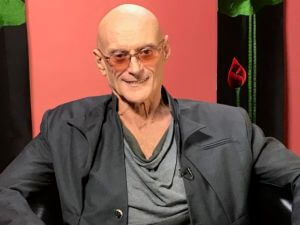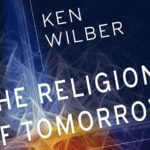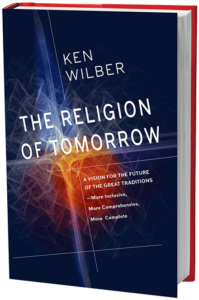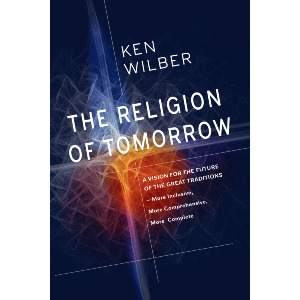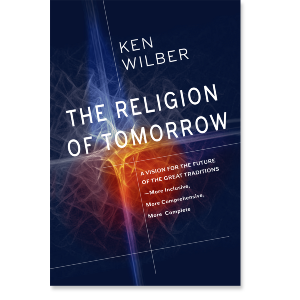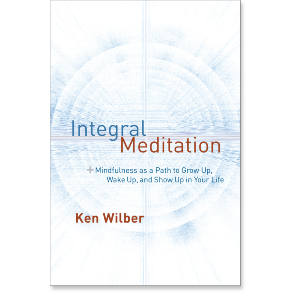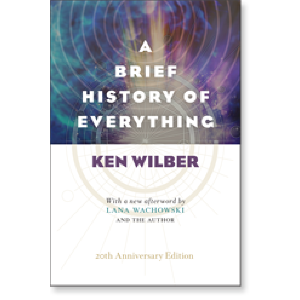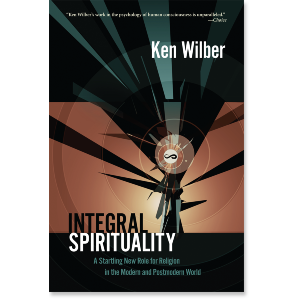A Religion of Tomorrow
This is a book about what a possible religion of tomorrow might look like. It is meant to apply across the field of the Great Traditions; I believe that all of them will, in fact, most likely end up incorporating many of these elements into their own fundamental teachings at some point, simply because the forces driving toward such are so varied and far‑reaching and, on balance, indeed make such a great deal of sense.
Nonetheless, in this particular presentation, I have chosen one religion—that of Buddhism—to use as a concrete instance, because specifics need to be given as actual examples of what is directly involved, and that requires a real religion to use as an example. I am not suggesting that Buddhism is somehow superior or more advanced and thus more open to this (in fact, as only one example, there are already a dozen books in print using exactly the same framework I will be introducing here to create a similarly “futuristic” Christianity). So there is no particular bias involved here; I believe any of the Great Traditions could be used as examples, and versions of many of them (including Christianity, Islam, Hinduism, and Judaism, as well as Buddhism) have already been presented following the same suggestions made in this book to show what would be involved in their own cases, with each of them indeed appearing to end up much more inclusive, complete, and comprehensive (not to mention fitting more easily with modern and postmodern developments, including those of basic science, without violating any of their main teachings).
So if you hail from a different faith—or if you are yourself “spiritual but not religious”—please work with me in the following pages and see how these suggestions could apply to your own spiritual path, formally or informally, and see if they don’t help address many problems that your approach may be facing in today’s world. Just see if the suggestions I’m about to offer don’t make a certain basic sense to you in many, many ways.
But we start with Buddhism. It has been close to three thousand years since Gautama Buddha sat under the Bodhi tree and arose with his Enlightenment, which marked the First Great Turning of the Wheel of Dharma (ultimate Truth); some eighteen hundred years since Nagarjuna and his genius birthed the Emptiness realization and the Second Great Turning; and some sixteen hundred years since the half brothers Asanga and Vasubandhu made the Third (and final) Turning of the Wheel of Dharma with the refinement of the Yogachara view. And even looking at the wondrous developments of Tantra, especially as pioneered in the great Nalanda University in India from the eighth to the eleventh centuries CE, it has been close to a thousand years since something profoundly new has been added to Buddha Dharma.
The world’s other Great Traditions find themselves in not much different circumstances, most of them being anywhere from one to three thousand years old. At the time that the major texts in all of these Great Traditions were first written, people really did think the earth was flat and was circled by the sun; slavery was taken to be the natural state of affairs, the way things were supposed to be (and this was challenged by none of the traditions); women were second‑class citizens, if even that; atoms and molecules were unknown; DNA was unheard of; and evolution crossed nobody’s mind.
And yet the world’s great contemplative and meditative systems—East and West—looked into the minds, hearts, and souls of men and women and came up with staggeringly astonishing discoveries, many as timelessly true and profoundly significant today as they were two thousand years ago. After World War Two, Jean-Paul Sartre was touring Stalingrad, scene of an epic battle between the Russians and the Germans, where the Russians—finally, and barely—defeated the Germans, at the cost of millions dead. “They were amazing,” Sartre mumbled under his breath. “The Russians?” his aide asked. “No, the Germans, that they got this far.”
That’s the only appropriate sentiment you can take toward these great adepts and ancient sages—that thousands of years ago, they got this far; they saw into the core of human beings and discovered, virtually each and every one of them, the ultimate Ground of Being, not only of humans but of the entire manifest universe. With no telescopes, microscopes, MRIs, or PET scans, they saw into the very essence of an ultimate reality that not only anchored all of manifestation but, when discovered, acted to radically free men and women from suffering itself, and introduce them to their own True Nature, known by many different names, but pointing to the same groundless Ground—Buddha-nature, Brahman, Godhead, Ayn Sof, Allah, Tao, Ati, Great Perfection, the One, Satchitananda, to name but a few.
That’s the only appropriate sentiment you can take toward these great adepts and ancient sages—that thousands of years ago, they got this far; they saw into the core of human beings and discovered, virtually each and every one of them, the ultimate Ground of Being, not only of humans but of the entire manifest universe
The “Exoteric” and “Esoteric”
Most of these traditions divided their teachings into two broad areas, often called “exoteric” and “esoteric.” The exoteric was the “outer teaching,” meant for the masses and the ordinary, and consisted of a series of tales, usually in mythic form, and it was taught that those who believed them would live everlastingly in a heaven with that tradition’s ultimate Being or God or Goddess. But the esoteric teachings were the “inner teachings,” the “secret teachings,” usually kept from the public and open only to individuals of exceptional quality and character. These teachings weren’t merely mythic stories and beliefs; they were psychotechnologies of consciousness transformation. By performing the specific practices and exercises, an individual could reach an actual awakening to his or her own True Nature, gaining a Great Liberation and ultimate Freedom from the terror‑inducing limitations of ordinary life and a direct introduction to ultimate Reality itself. This Great Liberation was also known by various names—Enlightenment, Awakening, moksha, kensho, satori, metamorphosis, emancipation, salvation. In all cases, it was said to be the discovery of the timeless and eternal, spaceless and infinite, Unborn and Undying, Unlimited and Unfettered, the one and only One and Only, ultimate Reality itself. As Arthur Machen’s fictional character Hampole so truthfully put it, of these esoteric practices:
Some have declared that it lies within our choice to gaze continually upon a world of equal or even greater wonder and beauty. It is said by these that the experiments of the alchemists of the Dark Ages . . . are, in fact, related, not to the transmutation of metals, but to the transmutation of the entire Universe. This method, or art, or science, or whatever we choose to call it (supposing it to exist, or to have ever existed), is simply concerned . . . to enable men [and women], if they will, to inhabit a world of joy and splendour. It is perhaps possible that there is such an experiment, and that there are some who have made it.
This experiment does indeed exist, and there are in fact many who have made it—that’s what the esoteric Paths of the Great Liberation are all about. Many of the original meditative schools that taught such practices are still flourishing to this day. Zen Buddhism, as one example, has been training individuals to discover their own Buddha-nature since the sixth century CE, when it was brought to China from India by Bodhidharma; Tibetan (Vajrayana) Buddhism, whose most famous follower is the Dalai Lama, was brought to Tibet in the eighth century by Padmasambhava and others, and is flourishing to this day; Vedantic Hinduism, one of the most sophisticated and philosophically astute of the Paths of the Great Liberation, is alive and well in India; and numerous contemplative schools exist in the West (from Jewish Kabbalah to Christian contemplation to Islamic Sufism) and are still passing on this “knowledge which is unto liberation.” All in all, they represent one of the great and extraordinary treasures of human history.
But they are, the lot of them, becoming less and less influential in the modern and postmodern world. One reason is that the only “religion” the West is generally familiar with is the “exoteric,” “outer,” mythic‑story type of religion, which retains much of the often childish qualities of the age that produced it, and becomes more and more embarrassing to modern men and women, silly even. Moses really did part the Red Sea? God really did rain locusts down on the Egyptians? Elijah really rose straight to heaven in his chariot while still alive? We’re supposed to believe that stuff? It’s not exactly an easy sell in today’s world, given that the same essential worldview can be produced by any five-year-old child.
But another reason is that, in the one or two thousand years since these Great Traditions were first created—and whose fundamental forms have not substantially changed since that time—there has been an extraordinary number of new truths learned about human nature, about the mind, emotions, awareness, consciousness, and especially the growth and development of human traits and qualities, not to mention the explosion in knowledge related to brain chemistry and its functioning, things that the ancients simply had no way to know, and so did not include in their otherwise so‑impressive meditative systems.
But what if that which we have since learned in the past thousand years, even the past fifty years, would actually affect how, for example, a person would directly experience Enlightenment or Awakening?
But what if that which we have since learned in the past thousand years, even the past fifty years, would actually affect how, for example, a person would directly experience Enlightenment or Awakening? What if we have discovered aspects of human awareness that most definitely determine how humans interpret any and all experiences that they have, and what if these interpretive frameworks, which will determine the different ways we directly experience Enlightenment, not only exist, but actually grow and develop through over a half-dozen well‑documented stages during a human’s overall life—and that they continue to develop during a human’s adult years? Awakening or Enlightenment is traditionally taken as being the unity of the individual self with ultimate Reality—what the Sufis call “the Supreme Identity”—resulting in a Wholeness or Nonduality, which, including all of reality, conveys a sense of utter Freedom and total Fullness to the individual. But what if these interpretive frameworks actually govern how individuals see and experience “Wholeness,” and thus directly determine how an individual experiences Enlightenment itself? That would change the nature of the Paths of the Great Liberation profoundly, with, in effect, a different “Liberation” being experienced at each of these different stages of growth and development. But the evidence is already in: those framework stages definitely exist—they have been found in over forty cultures (in every culture checked so far, in fact)—and they definitely alter how one experiences Enlightenment, or any other experience, for that matter. The very ground has shifted under the Great Traditions, and they don’t even know it.
All of the Great Traditions are certainly in need of this information; and I am going to suggest that all of them need to incorporate the types of facts that I will be introducing in the following pages. Of course, I say this in all humility, and in the spirit of suggestions to be considered honestly, not commands to be taken unreservedly. But I am going to present a series of arguments—and significant evidence and research—to back up every suggestion I make. The idea is not for any of the Great Traditions to throw over their accepted truths, dharmas, or gospels, but simply to add some of the following facts to their overall teachings. None of what follows threatens the essential truths of any of the traditions—these facts are rather additions, simple supplements, that could be quite easily included in any major tradition. (In fact, I will provide several examples from every single major tradition where these facts are already being used and are already incorporated into their core teachings—all with extremely positive outcomes.)
The “Integral” Approach
This “Integral” approach (meaning “inclusive,” as in including these new and major facts) is actually an approach that can be used in virtually any human discipline. Indeed, we already have seen the rise of things such as Integral Medicine, Integral Education, Integral Therapy, Integral Architecture, Integral Business and Economics and Leadership—all told, over sixty different disciplines have found this Integral approach enormously helpful and gratifying. And, as I said, virtually every major Great Tradition has some teachers who have included this Integral approach in their own teachings—including many “Integral Buddhists.”
And I believe that if spirituality is going to start having a real impact on the modern and postmodern world, it will have to include a fair number of these modern and postmodern facts that I am about to summarize for you.
And I believe that if spirituality is going to start having a real impact on the modern and postmodern world, it will have to include a fair number of these modern and postmodern facts that I am about to summarize for you. Failing to include them just makes the spiritual approach look truly dated, outmoded, and archaic, and that is one of the major reasons that religion is continuously losing ground in the modern and postmodern world—only 11 percent of northern Europe, for example, is “churched.” That is, only one out of ten people have anything to do with institutional religion; nine out of ten find it unbelievable and useless.
Not to mention the growing number of people who feel deeply spiritual but do not feel moved by any of the existing Great Traditions. There is a phrase for this that has become quite common: “I’m spiritual but not religious.” Polls show that some 20 percent of Americans identify overall with that phrase. And some polls have shown that, in the younger generation—those between eighteen and twenty-nine—this percentage explodes to an astonishing 75 percent! In other words, three out of four young individuals have a deep spiritual yearning that no existing religion is addressing. And I believe—and there is already a significant amount of evidence supporting this claim—that a more truly “Integral” spirituality speaks compellingly to this demographic.
The Fourth Turning
Although various teachers in all the Great Traditions have begun using this Integral approach, I chose Buddhism to use as an example, in this presentation, of what exactly would be involved. I did this for several reasons. As I pointed out earlier, this Integral approach has already been applied to many other Great Traditions (and this includes several Integral Buddhists), and I have written about many of these other traditions as well (the first book outlining this Integral approach for spirituality—namely, Integral Spirituality—was written as a nondenominational presentation designed and meant for any and all traditions). But it seemed an appropriate time to specifically address Buddhism as one of the many examples. Although I have practiced virtually all of the world’s great religions to varying degrees, I have spent an unbroken thirty years practicing Buddhism—fifteen years in Zen, then fifteen in Dzogchen and Mahamudra Tibetan Buddhism. But Buddhism also has a tradition—referred to as “the Three Turnings of the Wheel”—of tracing out its own evolutionary unfolding into wider and wider forms of belief and practice over the years, as if it understood that spiritual truths continue to grow and evolve, and that any spiritual system that wants to stay current and up-to-date needs to continue to expand its own teachings and include these new truths as they come into being. I therefore called a preliminary version of this present book The Fourth Turning; the title of that book itself implies a series of suggestions for Buddhism to actually take a Fourth Turning, in addition to its first Three Turnings, and incorporate some of the new facts I’ll be presenting here. Whether Buddhism actually takes a “Fourth Turn” or not, of course, depends upon Buddhism itself. But as the years stretch on, and it increasingly becomes longer and longer than a thousand years since new truths have been added in a new turning, the more likely it becomes that Buddhism itself will be seen as increasingly obsolete, out of date, out of touch, outmoded. This would be a disaster—not only for any Great Tradition that doesn’t take the leap—but especially for Buddhism, which contains perhaps the world’s most sophisticated and stunning understanding of meditation of any tradition anywhere, anytime. But what these new modern and postmodern discoveries have found, for example, is that the stages of meditation themselves will actually be interpreted and experienced quite differently depending on the stage of development of the individual doing the meditating—and this has been happening all along; it’s just that none of the Great Traditions were aware of it.
That particular discovery (which is only one of the half dozen or so major types of facts we’ll be looking at)—the idea that all humans grow and develop through up to a dozen stages of interpretive frameworks that govern how they interpret and therefore experience their world—involves something much like the existence of grammar. Every person brought up in a particular language‑speaking culture (German, English, Mexican, and so forth) will end up speaking that culture’s language quite accurately—they will put subjects and objects together accurately, they will use adverbs and adjectives accurately, and in general they will end up following the rules of grammar of that language quite correctly. But if you ask any of them to write down the rules of grammar that they are following, virtually none of them can do it. In other words, they are all following the rather extensive rules of grammar perfectly, and yet they have no idea that they are doing so, let alone what those rules are!
Growing Up and Waking Up
These stages of interpretive frameworks are just like grammar—they are “hidden maps” that determine how we see, think, and generally experience the real territory around us. If it were possible for a six-month-old to have a real Enlightenment experience—just play along here—whatever it would be like, we could be pretty certain that it would be different from how an adult would experience it. And the main reason, of course, is that the infant hasn’t yet really grown up. And it turns out that “growing up” means moving, growing, and developing through these stages of increasingly adequate interpretive frameworks—so much so, that I refer to the sequence of these stages as “Growing Up.” In that regard, these stages are distinguished from, say, the stages of meditative development that lead to Enlightenment, or Awakening—stages that I refer to as “Waking Up.” So, as we’ll continue to see in clarifying detail, human beings have two major types of development available to them: Growing Up and Waking Up.
And here’s the point. The states of awareness that constitute meditative states, or Enlightenment states, or Awakening states, or other types of “peak experience” states—these have been seen, known, and understood by humans for thousands and thousands of years, going back at least fifty thousand years to the first great shamans, who, in their vision quests, explored “altered states of consciousness” that were the forerunners to Enlightenment or Awakening experiences. These are direct, immediate, 1st‑person experiences that are very clear and very obvious when you have them, and these are the foundations of Waking Up. But these “hidden maps,” these hidden stages governing the overall processes of Growing Up, are not so obvious—just like the rules of actual grammar, they weren’t discovered until just about one hundred years ago. All the Great Traditions had long, long since been fixed, and none of them had a chance to include these stages of Growing Up with their carefully researched stages of Waking Up.
Does that really matter? I mean, Waking Up is Waking Up—when you discover your True Nature, or ultimate Reality, or pure Nondual Suchness, or radical Godhead, who cares what your “relative self” is like; you’ve just discovered your one and only Real Self, or true Suchness. But that’s exactly the point. In terms of the Buddhist notion of Enlightenment, which is the union of Emptiness (pure unqualifiable ultimate Reality) and all Form (the actual manifest world in its entirety), we could put it this way: Emptiness is not affected by whatever stage of Growing Up you might be at (although a certain minimum stage might be required—we don’t really think, for example, that six-month-olds could really experience Emptiness, even though they are drenched in it), but how you experience Form is directly related to the stage of Growing Up that you are at. As you will amply see in the following pages, the very experience of Form changes from stage to stage of Growing Up. Emptiness, being beyond manifestation per se, doesn’t grow or evolve—it has no moving parts—but remains rather the timeless Thusness, or Suchness, of what is; but the world of Form is exactly what does grow and evolve and change. Therefore, the union of Emptiness and Form will likewise change from stage to stage. In other words, the very core of the Enlightenment experience itself will differ considerably from stage to stage.
Not a single Great Tradition is even vaguely aware of this or has anything even close to these stages of Growing Up, for the simple reason that you can’t see these “hidden maps” by looking within. Just as if you look within right now, you will find no hint as to the actual rules of grammar that you are faithfully and fully following every time you think, speak, or write, so too if you look within, you will not see any of these “hidden maps” that, research confirms time and again, you are as faithfully and fully following as any rules of grammar. And yet exist they do, and they are largely determining how each one of us thinks, feels, and behaves, and these ways of thinking, feeling, and behaving change stage by stage by stage. The stage we happen to be at will even determine the likelihood that we will be interested in meditation to begin with! (In the following pages, as we go through these stages, you will quite easily be able to spot which stage you are likely at, and what you can do about it. . . . )
So the suggestion is simple: read over the following evidence, see if it makes sense to you, and if it does, then begin applying these facts to any discipline you’re now involved with—including, as noted, medicine or nursing, business, leadership, therapy, education, politics, law, international relations, among numerous others—or, the specific topic at hand, to whatever spiritual system you happen to be practicing, including, of course, Buddhism.
The discovery of these stages of Growing Up is one of around five or six other, equally important, modern and postmodern discoveries that affect the Paths of Waking Up in far‑reaching and profound ways. So the suggestion is simple: read over the following evidence, see if it makes sense to you, and if it does, then begin applying these facts to any discipline you’re now involved with—including, as noted, medicine or nursing, business, leadership, therapy, education, politics, law, international relations, among numerous others—or, the specific topic at hand, to whatever spiritual system you happen to be practicing, including, of course, Buddhism. The teachers of the Great Traditions who have already done so uniformly report a greater, more effective, more enhanced system of practice when these new areas are added to their standard training, which itself remains essentially the same—again, these are simple additions, not subtractions, supplements to be added to the standard practice, not things to be taken away from it. See if, by applying this Integral approach, your own practice doesn’t work better, faster, more effectively, and more efficiently.
And remember, these aren’t specifically my ideas; I’m simply taking research that has already been done by hundreds of other people and suggesting ways that it can be applied across the board in various areas. This isn’t something like “deconstruction,” a mere theory invented by Jacques Derrida that you can believe in or not, as you wish; it’s much more like “science,” research performed by knowledge communities in dozens of areas, repeated and confirmed, representing discoveries that have been made by humanity in the past thousand years—or even the past hundred years, or even the past ten. I have no doubt whatsoever that if any of the Great Traditions were being created today, they would categorically and absolutely include this information in their fundamental teachings, dharma, gospel, or dogma. In the areas we will examine, from “Cleaning Up” to “Showing Up” to “Growing Up,” these are facts that affect “Waking Up” in profound, far‑reaching, and absolutely crucial ways, affecting and changing the very nature of the Paths of Waking Up in ways that, I honestly believe, can no longer be ignored in our modern and postmodern worlds. It is time to bring all of the Great Traditions up to speed in this world, or watch the demographic they influence continue to shrink to 11 percent or less of the population, as the world increasingly looks to systems more up-to-date for guidance on when, where, why, and how to live their lives.
And this is an urgent, utterly urgent, task, because virtually none—not one—of the world’s modern and postmodern worldviews has anything resembling Waking Up. They know about Growing Up, and Cleaning Up, and Showing Up (the latter terms to be discussed below)—those are the only maps they use to make sense of the territory in which they find themselves—but of Waking Up, they know nothing, literally and absolutely nothing. This is a catastrophe of the first magnitude, a cultural disaster of unparalleled proportions.
Relative Truth and Ultimate Truth
The traditions uniformly divide truth into two categories: relative truth and ultimate Truth. Something like “Water consists of two hydrogen atoms and one oxygen atom” is a relative truth. But something like “Water itself is a manifestation of an ultimate Ground of Being” is an ultimate Truth. And ultimate Truth can’t readily or easily be put into words, although it can be experienced, or directly and immediately realized—namely, by taking up the meditative stages leading to a Waking Up. What one wakes up to is exactly ultimate Truth.
Our culture is awash in relative truths, in every sort of area imaginable, but it is absolutely bereft of ultimate Truth. Moreover, it doesn’t even suspect its existence; it is absent ultimate‑Truth knowledge, and absent an awareness of its absence—a double lack. It’s like frostbite: the affected area doesn’t hurt, so the person thinks that things are just fine, whereas it doesn’t hurt, not because things are fine, but because the person is numb and hence numb to the numbness itself. It’s a double absence, and it is killing this culture, top to bottom.
We are not short of criticisms of Western culture; it’s a hobby for any would‑be philosopher or sociologist anywhere, a cottage industry. We have critiques of capitalism, consumerism, sexism, racism, patriarchy, greed-driven business, fossil fuel energy, multinational economics, environmental despoliation, global warming, militarism, worldwide poverty, the gap between rich and poor, human trafficking, epidemic drug use and marketing, worldwide hunger, global water shortages, worldwide disease epidemics, increasing food shortages—and on and on and on.
I find merit in virtually all of those critiques. But there is one critique that is, arguably, as important as, or more important than, any of them that is never, but never, even mentioned—a critique based on the fact that Western culture has lost track of its own sources of Waking Up. It has no ultimate Truth as a North Star to guide its overall actions, which means, ultimately, it has no idea where it is actually heading. So it generally throws its hands up, and awaits technological advances to address any really severe and persistent headaches—after all, we do have the hi‑tech singularity headed this way, right? And it will soon enough solve all our problems, even some problems so difficult that we don’t even know we have them yet, but beyond‑brilliant computers will ferret out, pinpoint, and solve them, ushering in a transhuman heaven on earth, hallelujah!
It’s not that I have major disagreements with any of those views, either. It’s that they are all relative truths, relative realities, relative solutions. There is still no ultimate Truth, no Waking Up to an ultimate Reality, which, as the groundless Ground of Being, anchors and gives reality to any such relative endeavors in the first place. We are diving headfirst into the shallow end of the pool, and encouraging all of our fellow citizens to do the same as fast as they possibly can. It’s mass suicide; that’s what it is. And to make matters worse, we’re proud of it! Proud that we are wallowing in relative truths and that we adamantly maintain that there is no ultimate Truth anywhere anyway.
But ultimate Truth is not something that can be rationally demonstrated or proven. As the Great Traditions would put it, humans have at least three modes of knowing: the eye of flesh, the eye of mind, and the eye of contemplation. The eye of flesh is what grounds conventional science—all conventional science rests its proofs in sensory experience (or extensions of the senses, such as telescopes, microscopes, CAT scans, and X‑rays). The eye of mind gives us rationality, logic, and reason. Mathematics, for example, is a mental experience (nobody has ever seen the square root of negative one running around out there in the sensory world—it is a mental experience, pure and simple), and likewise logic, its rules and regulations, are mental experiences. And there are no sensory proofs for mental realities—there is no sensory proof for math or logic; can’t be done. The “eye of mind” is a higher-level development than the eye of flesh, and the lower cannot prove the higher. Likewise with the “eye of contemplation”—a higher level yet, which cannot be proven either by the eye of flesh or the eye of mind (senses, reason, or logic). The eye of contemplation is the eye with which a human has authentic spiritual experiences, and just as sensory experiences are the foundation for the natural sciences, and mental experiences are the foundation for mathematics and logic, so spiritual experiences are the foundation for Waking Up realizations—for Enlightenment, Awakening, metamorphosis, gnosis, jnana. And scholars of the mystical, or esoteric, or inner teachings of the world’s Great Traditions are fairly unanimous in saying that although the outer teachings of each tradition are considerably different, often even contradictory, the inner esoteric teachings, the teachings based not on beliefs but on direct spiritual experiences of Waking Up, show a remarkable similarity in what they say, which is why the mystics of virtually all the world’s religions have great ease in understanding each other, even as their exoteric brethren argue themselves silly.
But this universal core of Waking Up and ultimate Truth is, as we noted, slowly but surely becoming less and less influential everywhere in the world, and this is for two basic reasons: First, they are too often confused with the outer, exoteric, childish, mythic narratives that constitute probably 90 percent of the world’s religions as presently taught (and as humanity continues to mature, it increasingly finds these childish myths embarrassing and silly). Second, and this is what I am emphasizing, even the Waking Up schools have become out of touch, out of date, outmoded in certain ways, by simply failing to continue to add new and profoundly important truths to their own teachings. As I said, I have no doubt whatsoever that were these paths being created today, the Waking Up schools would absolutely include these truths as crucial components of their Waking Up teachings. Including these new truths and facts makes Waking Up work even better! Why on earth wouldn’t they include them?
I mentioned that the “hidden maps” of Growing Up are so hard to spot that they weren’t discovered until around one hundred years ago. Humans have been on this planet for hundreds of thousands of years, and only in the last one hundred years did they discover these maps, even though humans have been growing through them from the
start! Another discovery, barely any older, is that of evolution itself. All of human history, and it was only around 150 years ago that evolution itself was discovered. Modern science now believes that evolution touches essentially everything in existence (even though it is lagging behind theoretically on exactly how to explain this). But the fact of evolution (if not the “how” of evolution) is now undeniable. There are even leading‑edge thinkers who maintain that what humanity took to be immutable “laws of nature” are actually closer to “habits of nature,” that these “laws” themselves evolved over the years.
The Evolution of Religion
But that makes one thing certain: spiritual and religious systems themselves have undergone, and continue to undergo, evolution. It’s hard to read the Bible, for instance, and not notice the “growth” in God, from a childish, malicious, malevolent little monster—who in over six hundred passages early in the Bible recommends that his own people commit aggression and murder—to a being who recommends loving your enemies in all cases and always turning the other cheek. And what are the Buddhist “Three Turnings” but something close to an evolutionary unfolding of deeper and deeper truths and realizations? But one thing is for sure: whatever that evolution was, it didn’t up and totally stop one or two thousand years ago; no, evolution continued to unfold, whether it was realized or not. You can even see evolution as driven by “Spirit‑in‑action,” which I think is the only theory that can actually explain the mysteries of evolution satisfactorily; but in any event, spiritual realities have continued to unfold, to evolve, to follow what Alfred North Whitehead called that inexorable “creative advance into novelty.” And part of catching the traditions up with the modern and postmodern world is to simply follow their own evolutionary unfoldings as they continued over the ages (and they did continue, even if often in hidden and obscure sects and followings; but a trained eye can look at the history of virtually any religion and see, overall, movement through the stages of Growing Up—and these are parts of what need to be included in any new and updated Fourth Turning in any and every Great Tradition, if it is to find its way in the modern and postmodern worlds).
So that is the suggestion. Please take your time, and look over the following evidence, facts, and research, particularly as it applies to any spiritual system for Waking Up—I generally use Buddhism as an example, but my suggestions are meant to apply across the board—and see if some of it, at least, doesn’t make some sort of sense. And remember, we’re not taking anything away; this is not a painful subtraction of truths that you have become accustomed to; it is a simple addition, and in terms that can be completely accommodated to the already fundamental truths and doctrines of any tradition to which they are being added. These additions can be made in completely “kosher” forms to any tradition, as the many teachers in each tradition using an Integral approach have already demonstrated.
Above all, it is to preserve the ultimate Truth disclosed in the process of Waking Up that this effort is dedicated; this is such a precious, such a gorgeously glorious discovery of humankind, that the percentage of the population aware of its existence cannot be allowed to drop to 11 percent, then 5 percent, then 0 percent, as the only ultimate Truth ever uncovered by humankind is allowed to slip into the gutter and wash away into obscurity. A greater crime could hardly be imagined. But something, indeed, must be done, in terms of the packaging in which this ultimate Truth and Waking Up is presented—thousands‑of‑years‑old packaging not only has no interest for today’s humans, it isn’t even keeping up with Spirit‑in‑action itself. Spirit‑in‑action has itself moved and evolved well beyond the forms in which it presented itself to humans thousands of years ago, and it has been moving forward ever since, driving new discoveries in science, art, morals, education, politics, economics, and, yes, even religion and spirituality. However, the latter two fields suffer from arrested development, as it was believed that the original forms of spiritual presentation were somehow cut in stone, never to be changed or improved on again, and not to believe in their original forms was the equivalent of heresy, blasphemy, and horrid disbelief. Thus, the effects of Spirit‑in‑action were listened to in virtually every other area of human activity—from science to morals to medicine to economics—except in religion and spirituality itself, perhaps history’s greatest (and saddest) irony.
And remember, the discovery of this ultimate Reality is said to be not only the groundless Ground of all Being “out there” but also “in here”—it is the discovery of your own, truest, deepest Self and Suchness, the utterly most central and most real Reality of your own being, the discovery of which constitutes directly your own Awakening, your own Enlightenment, your own Metamorphosis:
Some have declared that it lies within our choice to gaze continually upon a world of equal or even greater wonder and beauty. It is said by these that the experiments of the alchemists of the Dark Ages . . . are, in fact, related, not to the transmutation of metals, but to the transmutation of the entire Universe. This method, or art, or science, or whatever we choose to call it (supposing it to exist, or to have ever existed), is simply concerned . . . to enable men [and women], if they will, to inhabit a world of joy and splendour. It is perhaps possible that there is such an experiment, and that there are some who have made it.
Well, there is such an experiment; and men and women for thousands of years have made it; and all have returned to tell a remarkably similar tale of what they saw and witnessed first hand, of the ultimate Reality to which they were introduced and that changed them deeply and forever. This is humanity’s one and only discovery of something that, once experienced, individuals almost unanimously claim to be an ultimate Reality, an Absolute Truth, the most real and most certain experience that they have ever had. This is the precious jewel that we must not let perish. This is the treasure we must not let go uncovered. This is the Truth that we must not let die. Please join me in taking steps that hopefully will help prevent perhaps the greatest catastrophe in humankind’s history, won’t you?
Related Books
$34.95 - Paperback
$39.95 - Hardcover
$16.95 - Paperback
A Brief History of Everything (20th Anniversary Edition)
$19.95 - Paperback
$34.95 - Paperback
